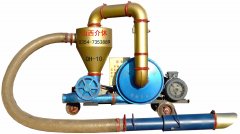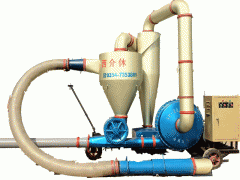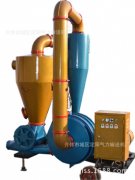
吸粮机应用介绍
A grain elevator is an agrarian facility complex designed to stockpile or store grain. In grain trade, the term grain elevator also describes a tower containing a bucket elevator or a pneumatic conveyor, which scoops up grain from a lower level and deposits it in a silo or other storage facility.
In most cases, the term grain elevator also describes the entire elevator complex, including receiving and testing offices, weighbridges, and storage facilities. It may also mean organizations that operate or control several individual elevators, in different locations. In Australia the term grain elevator describes only the lifting mechanism. (See "Usage", below.)
Before the advent of the grain elevator, grain was usually handled in bags rather than in bulk (large quantities of loose grain). Dart's Elevator was a major innovation. It was invented by Joseph Dart, a merchant, and Robert Dunbar, an engineer, in 1842 and 1843, in Buffalo, New York. Using the steam-powered flour mills of Oliver Evans as their model, they invented the marine leg, which scooped loose grain out of the hulls of ships and elevated it to the top of a marine tower.[1]
Early grain elevators and bins were often built of framed or cribbed wood, and were prone to fire. Grain-elevator bins, tanks, and silos are now usually made of steel or reinforced concrete. Bucket elevators are used to lift grain to a distributor or consignor, from which it falls through spouts and/or conveyors and into one or more bins, silos, or tanks in a facility. When desired, silos, bins, and tanks are emptied by gravity flow, sweep augers, and conveyors. As grain is emptied from bins, tanks, and silos it is conveyed, blended, and weighted into trucks, railroad cars, or barges, and shipped to grain wholesalers, exporters, and/or local end-users, such as flour mills, breweries, and ethanol and alcohol distilleries.
相关资讯
- 吸粮机在哪些行业中发挥
- 在农业生产领域吸粮机的
- 吸粮机成农业生产的必备
- 吸粮机的应用范围有哪些
- 吸粮机的吸嘴类型和特点
- 如何才能选到合适的吸粮
- 吸粮机的作用有哪些?
- 吸粮机的使用优点有哪些
- 如何让吸粮机发挥最大的
- 吸粮机的两种类型,看看
最新产品
同类文章排行
- 吸粮机多钱一套
- 低压气力输送
- 吸粮机 气力吸粮机 粮食专
- 小型吸粮机的发展情况介
- 使用气力输送机(吸粮机
- 气力输送设备之提升泵开
- 气力输送的基本原理2管流
- 气力输送泵怎么节约运行
- 粉体气力输送
- 气力输送的分类,吸粮机





